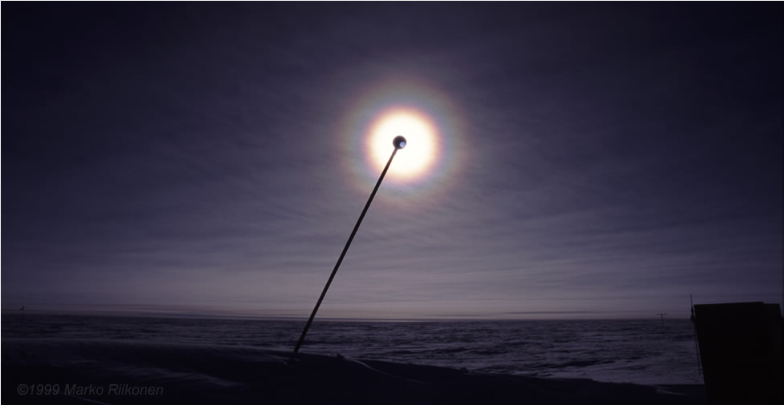South Pole Corona
South Pole Corona: A Phenomenon of Light and Cold
The South Pole, a place known for its extreme cold and desolate beauty, occasionally plays host to a mesmerizing atmospheric phenomenon known as the South Pole Corona. This captivating display of light occurs when a solar corona illuminates the vast icy landscape, creating a surreal and ethereal spectacle.
Captured on February 1st, 1999, by photographer Marko Riikonen, the image reveals a radiant halo suspended above the frozen terrain. Riikonen noted that the temperature on the ground was a bone-chilling -31.5°C, yet paradoxically, the temperature at the corona cloud level was higher due to supercooled water droplets. This observation suggests that the corona was likely formed by these unique droplets, defying the norms of homogeneous nucleation.
The South Pole Corona is a captivating example of how light interacts with atmospheric particles, resulting in a breathtaking visual display. Here are some fascinating details about this remarkable phenomenon:
-
Coronas and Their Formation: A corona is an optical phenomenon that occurs when light interacts with tiny particles suspended in the atmosphere, such as water droplets or ice crystals. These particles scatter and diffract light, creating a ring or halo of colors around a light source.
-
Supercooled Water Droplets: The South Pole's frigid temperatures can lead to the formation of supercooled water droplets, which remain in liquid form despite being below the freezing point. These droplets play a crucial role in the creation of the South Pole Corona, as they act as the scattering medium for the incoming sunlight.
-
Light Diffraction and Scattering: As sunlight passes through the supercooled water droplets, it undergoes diffraction and scattering. Diffraction causes the light to bend and spread out, while scattering scatters the light in different directions. The combination of these phenomena results in the vibrant halo seen in the South Pole Corona.
-
The Role of Ice Crystals: While supercooled water droplets are the primary contributors to the South Pole Corona, ice crystals also play a role in enhancing the visual spectacle. These ice crystals, which can form in the extreme cold, add an extra dimension to the corona's appearance, creating intricate patterns and colors.
-
Size Matters: The size of the water droplets and ice crystals influences the appearance of the corona. Smaller particles produce coronas with smaller rings and sharper edges, while larger particles generate larger rings and softer edges. The combination of different-sized particles can result in a complex and visually striking corona.
-
Weather Conditions and Visibility: The visibility of the South Pole Corona depends on various weather conditions. Clear skies with minimal cloud cover provide the best conditions for observing this phenomenon. Additionally, the position of the sun in relation to the observer is crucial, as the corona is most visible when the sun is low on the horizon.
-
Similar Phenomena Around the World: While the South Pole Corona is a unique spectacle due to its location, similar atmospheric optics phenomena can be observed in other parts of the world. Examples include the Arctic Corona, which occurs near the North Pole, and other types of halos and arcs that form under specific atmospheric conditions.
-
Scientific Research and Study: The South Pole Corona, along with other atmospheric optics phenomena, serves as a subject of scientific study and research. Scientists analyze these phenomena to gain insights into the properties of atmospheric particles, their interactions with light, and the overall dynamics of Earth's atmosphere.
-
Photography and Artistic Appeal: The South Pole Corona's breathtaking beauty has captivated photographers and artists alike. The ethereal halo against the stark backdrop of the frozen landscape offers a unique opportunity for creative expression. Photographers strive to capture the intricate details and colors of the corona, while artists often draw inspiration from its surreal aesthetic.
-
A Reminder of Nature's Wonders: The South Pole Corona serves as a reminder of the awe-inspiring wonders that nature has to offer. It showcases the delicate interplay between light and atmospheric particles, creating a moment of magic in an otherwise harsh and unforgiving environment. Observing this phenomenon reminds us of the beauty and complexity that surrounds us, even in the most extreme corners of the Earth.
The South Pole Corona stands as a testament to the captivating phenomena that can occur in Earth's atmosphere. It is a reminder of the intricate interactions between light and particles, showcasing nature's ability to create moments of beauty and wonder even in the harshest of environments. So, the next time you find yourself in the frigid lands of the South Pole, keep your eyes peeled for this mesmerizing display of light and cold.

A solar corona shines over the wastes of the South Pole. Imaged by Marko Riikonen (site) on 1st February 1999. Marko says "The temperature earlier on that day was -31.5 C on the ground. But at the corona cloud level it's warmer. and well above the temperature for homogeneous nucleation." So the corona was probably produced by supercooled water droplets. Image ©1999 Marko Riikonen, reproduced with permission.
Note: this article has been automatically converted from the old site and may not appear as intended. You can find the original article here.
Reference Atmospheric Optics
If you use any of the definitions, information, or data presented on Atmospheric Optics, please copy the link or reference below to properly credit us as the reference source. Thank you!
-
<a href="https://atoptics.co.uk/blog/south-pole-corona/">South Pole Corona</a>
-
"South Pole Corona". Atmospheric Optics. Accessed on November 26, 2024. https://atoptics.co.uk/blog/south-pole-corona/.
-
"South Pole Corona". Atmospheric Optics, https://atoptics.co.uk/blog/south-pole-corona/. Accessed 26 November, 2024
-
South Pole Corona. Atmospheric Optics. Retrieved from https://atoptics.co.uk/blog/south-pole-corona/.